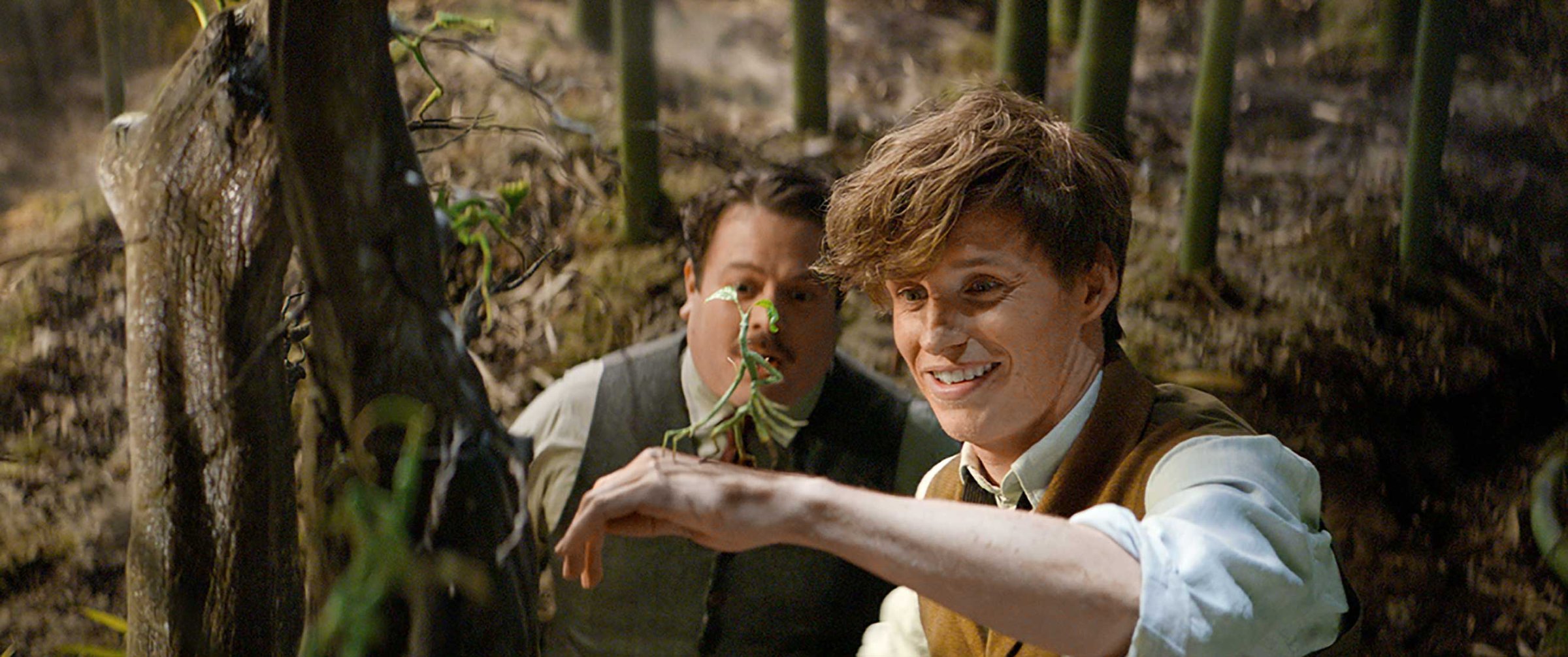
Eddie Redmayne is standing with his toes pointed out and his heels together. He picks up his right foot and very gingerly sets it down in front of him at the same awkward angle as it started, without creating any sound. “When you track a creature,” he explains, “if there are twigs and leaves and you don’t want to make a noise, you have to put one foot down as slowly as you can.”
Newt Scamander was described to him as a character who walks his own walk. Redmayne plays the eccentric magizoologist–screenwriter J.K. Rowling’s word for a witch or wizard who studies magical creatures–in Fantastic Beasts and Where to Find Them, a Harry Potter prequel set amid not the undergrowth of an enchanted forest but the social and political upheaval of New York City in the 1920s. Sitting with Redmayne at the Wooly, the retro-styled speakeasy in the basement of Manhattan’s Woolworth Building (which doubles as the American Ministry of Magic in the film), feels like time-traveling to that era.
Armed with an enchanted briefcase–in which the beasts under his care live–Newt arrives in Manhattan planning to complete a global research expedition before returning home to Europe. But when a chance encounter with a No-Maj, the American term for a nonmagical person, leads to the escape of several of his animal wards, he finds himself embroiled in a centuries-long conflict between the wizarding world and its secular counterpart.
Playing a wand-waving vagabond who spends his time studying imaginary creatures is by no means Redmayne’s usual shtick. In fact, the family-friendly Fantastic Beasts franchise–which is set to span five movies in all–is the first multi-installment series for the actor, 34, best known for starring in a string of critically acclaimed one-shots over the past few years, the most famous of which were grounded in actual history: those roles included Lili Elbe in The Danish Girl, which earned Redmayne a Best Actor nomination at the Oscars, and Stephen Hawking in The Theory of Everything, for which he won in the same category.
The shift to lighter subject matter brought no change in Redmayne’s preparation, though. A Method actor, he researched the role by going into the field. “I went to a wildlife park,” he says, “and met people who care for animals and watched all the idiosyncrasies of both how the animals behave and how the people who look after them behave.”
On its face, the action of Fantastic Beasts centers on a practical matter: Newt’s quest to retrieve his creatures. But on a deeper level, it explores the themes of intolerance and otherness that figure prominently in Rowling’s seven-book Potter series. Our British hero struggles to understand the American laws that call for complete separation of the magical and nonmagical communities, a practice he without hesitation condemns as “backwards.”
Redmayne says Rowling’s ability to craft narratives that are entertaining but carry a message was a big part of the project’s appeal for him. “She’s weaving in bigger themes of repression and segregation,” he says, “but manages to touch on them with a lightness that sticks with you afterward.”
At the same time, even with its fantastical elements–including a rhino variant packing an explosive horn–Fantastic Beasts has all the hallmarks of a Redmayne film. Not so much as an awards contender, perhaps, but as a story that asks big questions while leaving room for a sensitive performance. “You can only go on one’s instinct for these things and for me, it normally tends to be a physical reaction. I felt it in The Theory of Everything and similarly in this.” That gut feeling was what ultimately persuaded him to take on this ambitious commitment. “The script just did something really special that I thought was really unique,” he says. “It was all these different genres somehow–there was high comedy and yet it left me really emotional.”
Of course, there’s also the allure of being inducted into the much beloved Potterverse–a global phenomenon since the release of Rowling’s first novel in the summer of 1997. Callbacks to Potter‘s story are scattered throughout Fantastic Beasts, references that gave Redmayne a strong sense of nostalgia while reading Rowling’s screenplay (which Amazon, prepublication, lists as the No. 1 best seller in children’s reptile and amphibian books). “It had all this familiarity and the names of characters you’ve heard of and relatives of various protagonists from the Potter films,” he says, “but in something that felt like its own thing.”
Redmayne has his own ideas as to why the lore of Rowling’s creation appeals so broadly. “I think all of us love escapism,” he says. “The idea that there is a magical world running simultaneous to ours that is somewhere we can escape from the daily grind is kind of wonderful.”
Although it’s on track to earn a lower opening-weekend gross than any of the eight Potter films, there are nonetheless high expectations for Beasts. It debuts on the heels of other Rowling releases that have renewed fan excitement, including the two-part play Cursed Child that opened on London’s West End and three collections of short stories. But it’s the first opportunity audiences will have to return to the big-screen wizarding world in more than five years.
For his part, Redmayne is confident in his quirky protagonist’s ability to enchant both new and returning viewers. “You realize he has great passion and qualities that don’t immediately seem heroic,” he says, “but a heart that’s quite heroic.” Put it this way: Newt’s walk may look different, but it’s clearly within Redmayne’s stride.
More Must-Reads from TIME
- Cybersecurity Experts Are Sounding the Alarm on DOGE
- Meet the 2025 Women of the Year
- The Harsh Truth About Disability Inclusion
- Why Do More Young Adults Have Cancer?
- Colman Domingo Leads With Radical Love
- How to Get Better at Doing Things Alone
- Michelle Zauner Stares Down the Darkness
Write to Megan McCluskey at megan.mccluskey@time.com